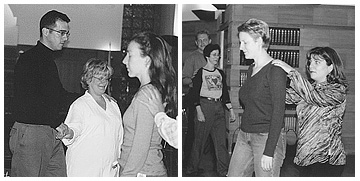Blind Lead
ACTIVITY

Step 1. Lead or Follow: Gather participants in a circle and have them form partner pairs. To demonstrate the first step, “borrow” a partner and tell her to close her eyes. Say: “Now I’m going to take my partner for a walk,” and begin moving the “blind” partner around the space, demonstrating that she can be guided from in front (pulled), gently directed from behind (pushed), led by one hand or two, or by contact between various parts of the body. Emphasize that while leaders may change the point of contact, they should never let go entirely.
Participants decide who will lead and who will follow. They do the exercise for approximately 3 to 5 minutes. Tell participants to switch roles and continue the activity for an equal amount of time.
Ask “What did you observe.” After a few minutes of discussion, continue to step two.
Step 2. Change Partners, Change Roles: Using a demonstration partner as needed, describe the new elements: Now leaders may bring their partners to a stop and walk away from them. At this point “blind” partners have two choices: 1) They may stand in place until another leader claims them; or 2) They may open their eyes, start moving and claim a partner who is waiting with eyes closed. Likewise a person who has been leading may either: 1) begin leading a new partner from among those standing and waiting; or 2) stop, close eyes, and wait to be led. One person may change roles several times. Emphasize that if you are standing still, your eyes should be closed. If you are moving, you should be leading someone, being led, or finding someone to lead.
Again, follow the exercise by asking for observations.
APPLICATIONS
Blind lead is often presented early in a workshop as one of the first structured activities engaging the group. It introduces partnering and can offer a spring board to deepen movement exploration, help to surface common or varied concerns within a group, and lay the groundwork for effective collaboration.
Specific applications of Blind Lead are often inherent in the observations that different groups bring to the exercise. Frequently during the discussion, a participant will observe that the activity is “an exercise in trust.” This is a useful idea, particularly in a gathering where unfamiliar groups may be encountering one another for the first time. It is important, however, to allow this interpretation to emerge from the discussion rather than imposing it from the outset, where it can tend to reduce an understanding of other possibilities.
Blind Lead will often inspire a discussion of leading and following, participants’ comfort with one role or the other, and the observation that you become a better leader once you have had a chance to follow. It can enable a group to get new perceptions about a person’s expected role, as when a troop of community police – expected to be leaders – had the opportunity to be perceived as followers. Almost any group of professionals is likely to gain insight into some aspect of its practice, as when a group of social workers discovered how accustomed they were to taking charge when they all decided to assume the role of leaders.
FOOTNOTES
Make your language as direct and physically specific as possible: “Find a partner.” “Don’t let go.” In instigating discussion, it is critical to ask for observations rather than feelings, since it focuses the discussion on a wider and less subjective range of responses.
Blind Lead is based on a structure which Liz Lerman learned from choreographer and dancer Cathy Paine.